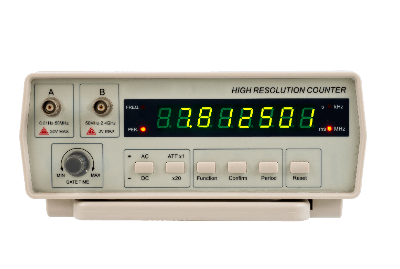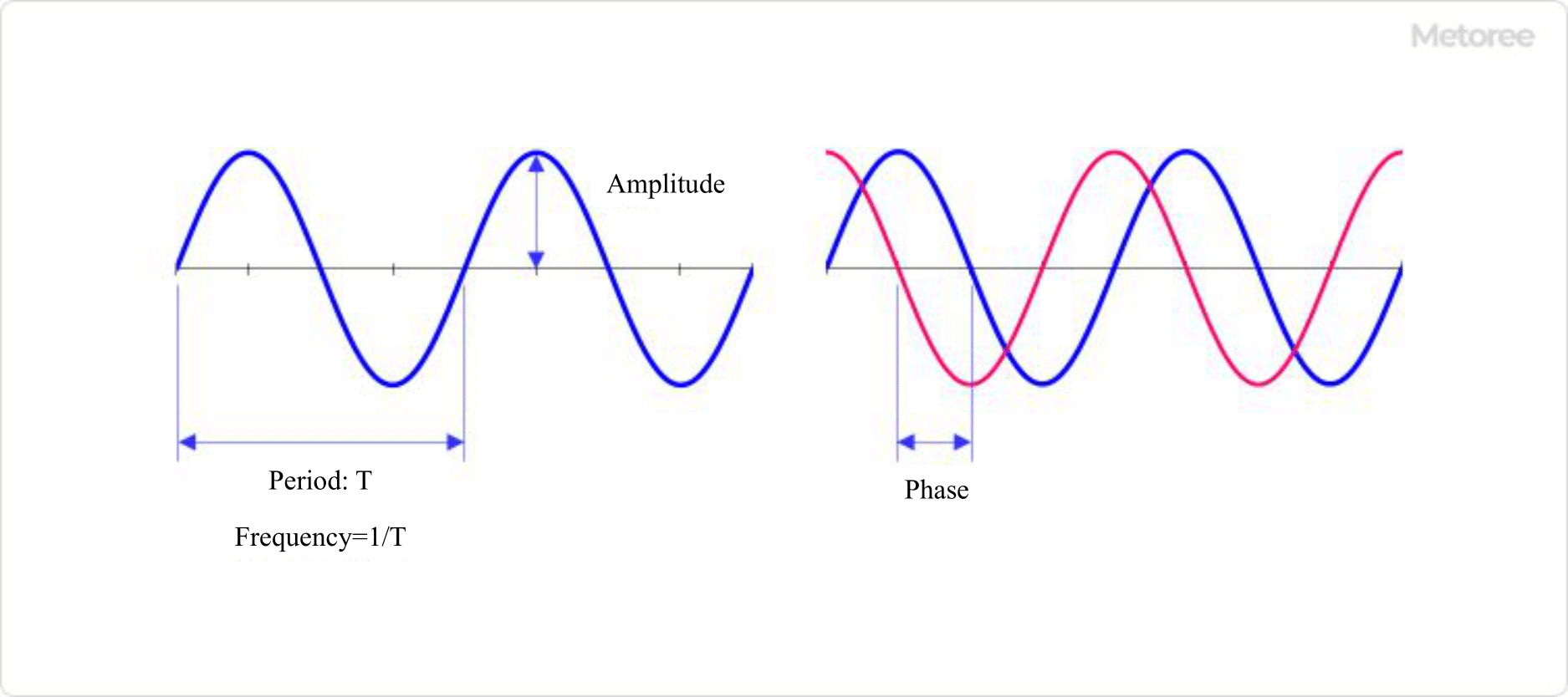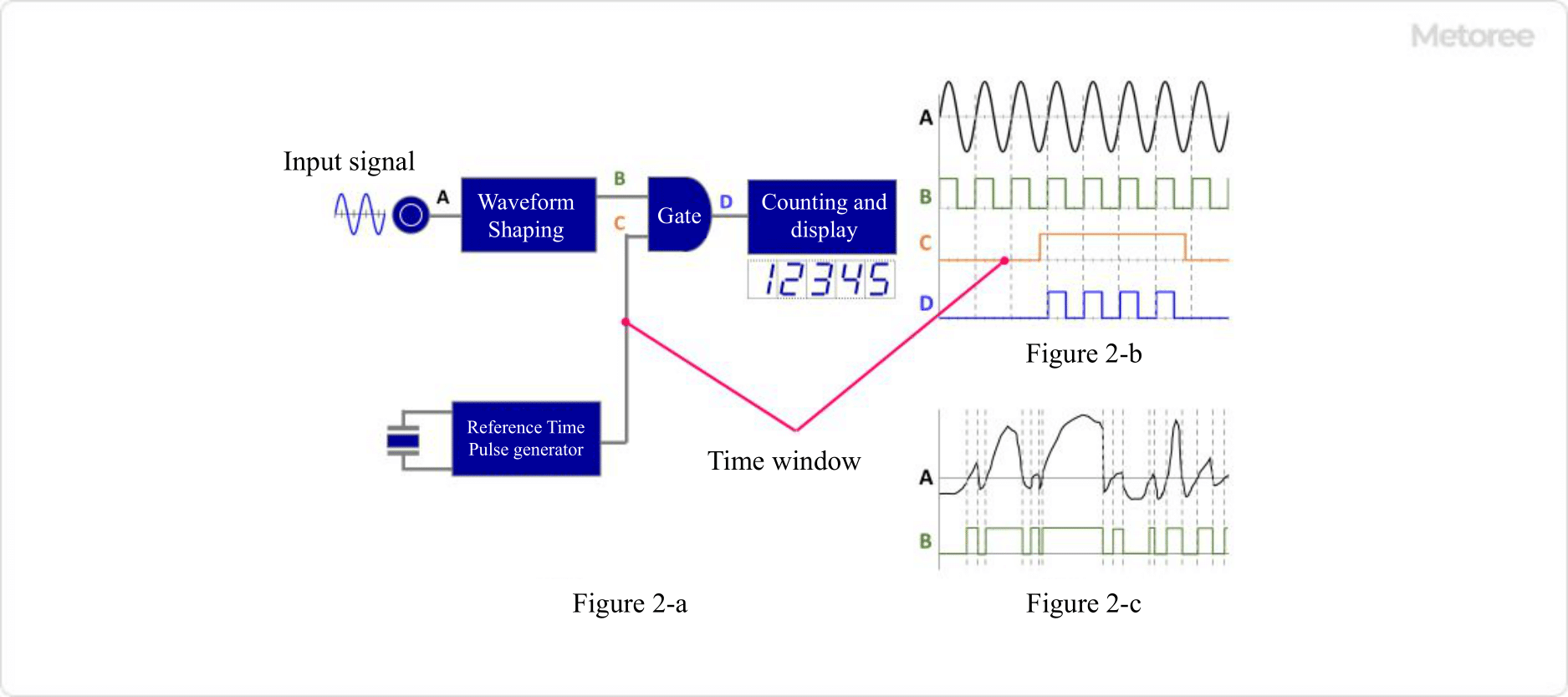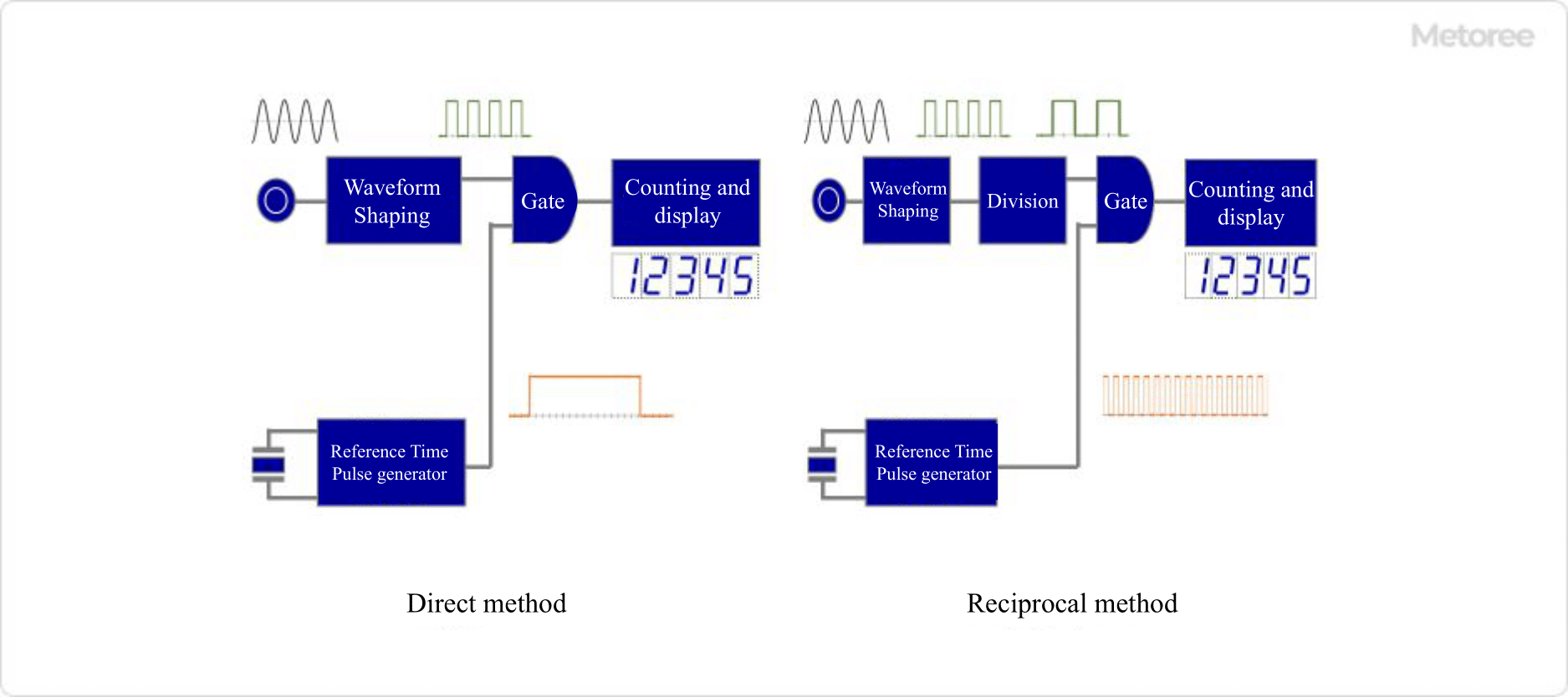











21 Frequency Counter Manufacturers in 2024
This section provides an overview for frequency counters as well as their applications and principles. Also, please take a look at the list of 21 frequency counter manufacturers and their company rankings. Here are the top-ranked frequency counter companies as of October, 2024: 1.Anritsu, 2.Keysight Technologies, 3.Allied Electronics, Inc..
Table of Contents
What Is a Frequency Counter?


Figure 1. Three parameters of an electrical signal waveform
A frequency counter is a digital device used to measure the frequency occurring in an electronic circuit.
An electrical signal can be expressed in terms of three parameters: frequency, amplitude, and phase. It is also possible to determine the period by the reciprocal of the frequency. Frequency measurement is an important parameter in the basic measurement of electrical signals.
In addition to the frequency counter, those with several additional functions, such as duty cycle measurement, pulse rise time, and time interval, are called universal counters.
Uses of Frequency Counters
Frequency counters are used as basic measuring instruments in electrical signal measurement, like ammeters and voltmeters. Although some products are available as stand-alone frequency counters, many products have been developed with frequency counter functions as part of the functions of devices with many functions, such as digital multimeters, oscilloscopes, and optical spectrum analyzers.
Frequency counters are characterized by the fact that their principle is very simple. Since it is possible to make your own frequency counter, kits are available. Frequency counter kits are available from various companies for several tens of MHz. The reason for this is that direct-type frequency counters are characterized by their uncomplicated operation.
Some multi-testers are equipped with a frequency measurement range, and these types are especially useful at sites where large measurement equipment cannot be brought in, because they can be handled easily. However, while they have the advantage of being easy to use, their disadvantage is that they are not suitable for applications that require high frequencies or a large number of significant digits.
Since most of the kits are LSI-based, you cannot learn the entire structure, but you can get a feel for it.
Principle of Frequency Counter

Figure 2 Principle of frequency counter (Direct method)
A frequency counter consists of a waveform shaping circuit, a gate, a crystal oscillator, and a counting circuit.
1. Waveform Shaping Circuit
Converts the input signal into a "pulse train."
2. Crystal Oscillator
Generates pulses with a fixed time width. Generates a time window (gate time) for measuring the pulse train described earlier, and the time window serves as a window for measuring the frequency.
3. Measurement Circuit
The frequency of the original signal is measured by counting the number of pulses in the time window. The resolution of the frequency measurement is determined by the time width of the time window generated by the crystal oscillator. For example, a time window of 1 second allows the frequency to be displayed in units of 1 Hz, a time window of 0.1 second is 10 Hz, and so on. The resolution is proportional to the inverse of the time window width.
In frequency counters, the most error occurs at the point where the pulse train is generated, especially if the input signal contains noise, which can cause the rising edge of the pulse to be unstable or generate extra pulses that should not be there.
The method used to prevent the generation of errors is to perform repeated measurements and average out the noise components. This reduces the errors that occur when generating pulse trains.
Frequency Counter Measurement Method

Figure 3. Frequency counter system
A frequency counter is a device that measures the frequency of an input signal and displays the result. There are two measurement methods: the "direct method," which has been used for a long time because it is easy to implement, and the "reciprocal method," which is expensive but can obtain a high number of significant digits.
1. Direct Method
Zero Point Cross Measurement
The direct method frequency counter measures the number of times the frequency of the input signal crosses at the zero point. If the input signal is a sine curve, it counts the number of times it crosses either down or up to the zero point. The advantage of the direct method frequency counter is that it can be easily implemented using only hardware. For this reason, this method has been used for a long time, and its number of zero point crossings per second is displayed as a frequency measurement.
The direct method frequency counter is characterized by the fact that an accurate reference clock is made inside the device, and the number of times the zero point is crossed is measured by opening a time window for that amount of time.
Number of Significant Digits in Measurement
The number of significant digits in a direct method frequency counter is determined by the time width of the time window and the input frequency. For example, if the input frequency is 1 GHz and the time window is 1 second, the measured value is 1x10^9 and the number of significant digits is 10. If the input frequency is 1 kHz, the number of significant digits is 4, and the resolution for both is 1 Hz.
For example, if the time window is 100 seconds, the number of significant digits is 6 at 1 kHz, and the resolution is 0.01 Hz. However, taking at least 100 seconds for a single measurement is not realistic and significantly reduces workability. It should also be used with the understanding that the measured value will always have a quantum error of ±1.
If you are only measuring high-frequency signals, you can use a direct method frequency counter without any problems, but to increase accuracy with the direct method, you need to increase the time window time width. However, the direct method has the disadvantage of extremely low efficiency because the longer the time window, the longer the time required for each measurement. Frequency Counter of "Reciprocal Method" is an alternative in such a situation.
2. Reciprocal Method
A reciprocal frequency counter counts the input waveform as it is or divides it by an internal reference clock. The advantage of this method is that a high number of significant digits can be obtained, especially when measuring low frequencies. The number of significant digits in a reciprocal Frequency Counter is determined by the internal reference clock and gate time, and is not affected by the input frequency.
For example, if the internal reference clock is 10 MHz and the gate time is 1 second, the number of significant digits is 7. Although the reciprocal method is capable of obtaining a high number of significant digits in measurements in the low frequency counter range, it has the disadvantage of being expensive because the operation of the counter itself is complex.
List of 21 Frequency Counter Manufacturers
*Including some distributors, etc.
Sort by Features
- Default
- Company Size: largest first
- Year Founded: oldest first
- Year Founded: earliest first
Sort by Area
- United States of America
- China
- France
- India
- Japan
- Spain
- Taiwan
- Turkey
-
-

-
Madell Technology Corporation
INSTEK GFC-8270H - INTELLIGENT COUNTER
Manufacturer Overview
Madell Technology Corporation, founded in 2004 and headquartered in Ontario, California, USA, is a designer and a manufacturer of SMT equipment and tools. The company offers electronic test and measurement instruments, rework stations, and various laboratory equipment. It also specializes in power transformers, heating elements, solder iron tips, white LED ring lights, and replacement heat tubes, primarily serving the electronic manufacturing sectors. The company offers small quantity PCB assembling as well as technical resources, including dummy components and practice kits.
-
-
-
-

-
Rohde & Schwarz USA, Inc.
Universal counter
Manufacturer Overview
Rohde and Shwarz, headquartered in Munich, Germany, is a technology business that creates, develops, and promotes innovative information and communication technology products for professionals. Customers all over the world rely on Rohde & Schwarz and its cutting-edge solutions in the test & measurement, secure communications, networks & cybersecurity, and broadcast & media areas. They were created in 1993 and have regional hubs in Asia and the United States.Rohde & Schwarz has invested heavily in emerging technologies such as artificial intelligence, the industrial internet of things (IIoT), 6G, cloud solutions, and quantum technology.
-
-
-
-

-
Stanford Research Systems
Frequency Counter
Manufacturer Overview
Stanford Research Systems Inc., founded in 1980 and based in Sunnyvale, California, is a manufacturer of test and measurement instruments for corporate, government, and academic users. Its products include lock-in amplifiers, FFT spectrum analyzers, and mass spectrometers, and it also provides software and drivers. The company’s CS580 voltage-controlled current source can source and sink DC and AC currents from 100 fA to 100 mA and has a maximum compliance voltage of ±50 V, which is adjustable. The company accepts online orders from the US and international buyers and offers Net 30 payment terms to a majority of its global customers.
-
-
-
-

-
B&K Precision Corporation
Frequency Counter
Manufacturer Overview
B&K Precision Corporation, established in 1951 and headquartered in Yorba Linda, California, stands as a manufacturer and supplier of test and measurement instruments. Its offerings span various industries and applications, including power supplies and DC electronic loads for power testing, signal generators for signal creation, component testers for evaluating electronic components, oscilloscopes for signal waveform analysis, and spectrum analyzers for frequency spectrum measurement. These solutions provide more options for electronic system design and development across education, research, engineering, production, and maintenance sectors. The company holds ISO 9001:2015 certification for its quality management.
-
-
-
-

-
Allied Electronics, Inc.
Frequency Counters
Company Overview
Allied Electronics Inc., founded in 1991 with headquarters in the USA, is a distributor and supplier of fuel and vehicle servicing station equipment and accessories. The company's extensive product line of over 57,000 products includes forecourt controller parts, fuel dispenser parts, air compressors, and power conditioners. The company also provides rebuilt parts by brands that include Bennett, Daktronics, FE-Petro, and Gasboy. The company's services include equipment financing, primarily serving the retail petroleum industry, including car wash and price sign manufacturers.
-
-
-
-

-
B&K Precision
Deluxe Function Generator
Company Overview
B&K Precision established in Yorba Linda, California, in 1951 is a manufacturer of Test & Measurement Equipment used in production line testing, industrial maintenance, and electronic field services. Their product portfolio includes Power Supplies, DC Electronic Loads, Oscilloscopes, Signal Generatorsand Multimeters. In 2004 the company expanded its presence in Europe through the acquisition of Sefram Instruments. The company has offices in North America, Europe, and Asia and works with an international network of authorized distributors, and provides global customer service.
-
-
-
-

-
Keysight Technologies
Frequency counter
Company Overview
Keysight Technologies, Inc. was founded in 1939 and headquartered in Santa Rosa, California. Keysight is a global developer and manufacturer of electronic design and test solutions to communications, networking, aerospace, defense, and government, automotive, energy, semiconductor, electronic, and education industries. Keysight’s communications solutions group solutions include electronic design automation software; radio frequency and microwave test solutions, hardware and virtual network test platforms and software applications, as well as optical laser source solutions. Keysight’s electronic industrial solutions group offers various design tools and verification tools. Keysight offers product support, technical support, and training and consulting services. It sells its products through direct sales force, distributors, resellers, and manufacturer's representatives.
-
-
-
-

-
PROMAX Test & Measurement SLU
FREQUENCY COUNTER
Manufacturer Overview
Promax Test & Measurement SLU, founded in 1963 and based in Barcelona, Spain, is a manufacturer of telecommunication instrumentation and electronics equipment. The ISO 9001-certified company stocks products like digital modulators for broadcast, earth resistance meters, and optical fiber fusion splicers used to provide testing solutions for satellite, cable, and digital terrestrial television. It stocks over 200 products at its Barcelona facility, with 18 calibration centers and several service centers worldwide. It produces on-demand PCB circuit boards and electronic equipment and offers software development, training, and industrial design services.
-
-
-
-

-
Shijiazhuang Suin Instruments Co., Ltd.
SS7406
Manufacturer Overview
Shijiazhuang Suin Instruments Co., Ltd., located in Shijiazhuang, Hebei, China, and founded in 1996, is a manufacturer of test & measurement instruments, electrical products, and application software. Its product portfolio includes signal generators, spectrum analyzers, frequency counters, power quality analyzers, and programmable DC power supplies. These products cater to a wide range of applications within the test & measurement industry, such as electronic circuit analysis, telecommunications signal analysis, frequency measurement, power quality assessment, and precise control of DC power supplies.
-
-
-
-

-
Good Will Instrument Co., Ltd
Frequency counter
Manufacturer Overview
GW Instek or Good Will Instruments is a Taiwanese instrument maker founded in 1975. GW Instek has over 300 product lines, which include Oscilloscopes, Spectrum Analyzers, Signal Sources, Basic Tests and Measurement Instruments, Safety Monitoring Systems, and more. Leading manufacturers choose them as their test and measurement provider. GW Instek has become the leading brand in the electronic test and measurement industry. They help electronic industries reduce testing costs and increase competitiveness. GW Instek has subsidiaries in five countries and is sold to more than 80. Their mission is to reduce total costs and create customers value from cost savings.
-
-
-
-

-
Anritsu
Microwave frequency counter
Manufacturer Overview
Anritsu Corporation, established in 1931 and based in Atsugi, Japan, is a manufacturer of electronic measuring instruments, quality assurance systems, and Information and Telecommunication equipment and devices. Its test and measurement products include power meters, power sensors, and conformance test systems, while X-ray inspection systems, metal detectors, and checkweighers ensure food safety and security. Other products like instrumentation-grade adapters and optical sensing equipment are used in IT. The company’s stock was listed in the 2nd section of the Tokyo Stock Exchange in 1961, and in 1968, it was listed in the 1st section.
-
-
-
-

-
TEKTRONIX, INC.
Frequency Counters
Manufacturer Overview
TEKTRONIX, INC., founded in 1946, is a manufacturer of measurement solutions used in 3D sensing, EMI/ EMC testing, high-speed serial communication, material science engineering, and Wireless & RF testing. The products include oscilloscopes & probes, signal generators, margin testers, multimeters, and analyzers. The company's products are used in advanced research, aerospace & defense, automotive, power semiconductor, and medical industries. The Bracknell Berkshire company offers calibration, repair, asset management, package assembling, and testing services following NEMA, HAlT & HASS, environmental, and shock-vibration testing.
-
-
-
-

-
Simpson Electric
Frequency Counters
-
-
-
-

-
Selec Controls
LED FREQUENCY METER
Company Overview
Selec Controls, founded in Navi Mumbai, Maharashtra, in 2000 is a manufacturer of Electrical Measurements and Protection, Meters, and, Automatic Power factor controllers. The company's product portfolio includes Indicators and Controllers, Digital Timers, Temperature Controllers, Speed Monitoring Relays and Humidity and Temperature Controllers. The company serves industries such as Oil and Gas, Aerospace and Defense, Automotive and Transportation, Construction, and Power Generation. The company has 200+ distributor network and global sales offices.
-
-
-
-
-
Lutron Electronic Enterprise Co., Ltd.
FREQUENCY COUNTER
Company Overview
Lutron Electronic Enterprise Co. Ltd., established in 1976, and headquartered in Taiwan, is an ISO 9001-certified manufacturer in the fields of test and measurement instruments. Operating from its 6,410 square meters / 69,000 square feet factory, the company consistently introduces a wide range of instruments to the markets. Among its offerings are barometers, density meters, and digital multimeters. Additionally, it provides related accessories like surface wheel adapters and data acquisition software.
-
-
-
-

-
Tense Elektronik
FREQUENCYMETER
Company Overview
Tense Elektronik is a manufacturer and supplier of electronic products and technologies in industrial automation solutions established in Turkey since 2006. The company specializes in automatic control sensors, controllers, energy analyzers, multimeters, frequency meters, ammeters, timers, among others. It serves industrial sectors such as automotive, manufacturing, construction, food and aerospace. The company's products improve operational efficiency, fluid processes in industries and the optimization of production lines and quality control processes. The company has certification in the Iso 9001:2015 Quality Management System, TSE Certificate and RoHS.
-
-
-
-

-
Saluki Technology Inc
S4382 Series
Company Overview
Saluki Technology Inc., founded in 1997 and based in Taipei, Taiwan, is a manufacturer and supplier of test, lab, and communication equipment. Its product portfolio includes RF microwave test equipment, amplifiers, and satellite telecommunication equipment. It also stocks RF components like calibration kits, coaxial adapters, and cable assemblies. The company’s SGM150/SGM200 signal generator module covers frequencies of up to 15GHz and 20 GHz and supports several modulation types, including PM, FM, and AM. The company has customers in over 50 countries and can provide products from brands like Fluke, KeySight, and Tektronix.
-
-
-
-

-
Aim and Thurlby Thandar Instruments,
TF900 Series
Company Overview
Aim and Thurlby Thandar Instruments, founded in 1989 and based in Huntingdon, UK, is a manufacturer of electronic test and measurement equipment and laboratory supplies. Its products include EMC analyzers, waveform amplifiers, pulse generators, multimeters, and DC power supplies. It also provides accessories related to the products, including power adaptors, cases, rack mounts, cables, and connectors. The company complies with the WEEE directive, and all its products are listed in Annex I of the RoHS directive. It sells its products worldwide through various distributors, and all the products are designed and manufactured at the Huntingdon facility.
-
-
-
-

-
Radar Technology, Inc.
Automatic frequency control RTDAFC
-
-
-
-

-
GAOTek Inc.
GAOTek High Frequency LCR Meter
Company Overview
Gao Tek Inc., started in 2001, and headquartered in Manhattan, New York, is a supplier of test and measurement equipment like embedded development tools, electronic measurement instruments, and telecommunication testers. The company is a B2B tech supplier that also stocks drone products, commercial gas detectors, and transceivers and is incorporated in the USA and Canada. It provides a one-year product warranty against defective material or workmanship and offers overnight delivery in the continental USA and Canada. It is a member of the GAO group and has served customers in over 50 countries worldwide.
-
-
-
-

-
Ardetem-Sfere
Digital Panel Meter
Distributor Overview
ARDETEM-SFERE, founded in France in 1987, is a distributor of automation equipment. The company provides multiple products and services, including the LCD touchscreen console sfere with miniaturized interfaces for configuring and downloading the new range of the company's signal product, the signal transmitter AVTN, which accepts a non-standard signal and converts it into a standard output signal, and differential relays ELR20-30/TYPE A designed for the limitation of the earth leakage current of type A.
-
-
Frequency Counter Manufacturer Ranking
*Including some distributors, etc.Ranking as of October 2024
Derivation Method| Rank | Company | Click Share |
|---|---|---|
| 1 | Anritsu |
12.1%
|
| 2 | Keysight Technologies |
9.6%
|
| 3 | Allied Electronics, Inc. |
8.3%
|
| 4 | Shijiazhuang Suin Instruments Co., Ltd. |
7.0%
|
| 5 | Good Will Instrument Co., Ltd |
7.0%
|
| 6 | Madell Technology Corporation |
6.4%
|
| 7 | B&K Precision Corporation |
6.4%
|
| 8 | Stanford Research Systems |
5.7%
|
| 9 | Rohde & Schwarz USA, Inc. |
4.5%
|
| 10 | Ardetem-Sfere |
3.8%
|
Derivation Method
The ranking is calculated based on the click share within the frequency counter page as of October 2024. Click share is defined as the total number of clicks for all companies during the period divided by the number of clicks for each company.Number of Employees
- Anritsu: 4,168
Newly Established Company
- Madell Technology Corporation: 2004 (20 years ago)
- Ardetem-Sfere: 1987 (37 years ago)
- Rohde & Schwarz USA, Inc.: 1978 (46 years ago)
Company with a History
- Anritsu: 1895 (129 years ago)
- Simpson Electric: 1936 (88 years ago)
- TEKTRONIX, INC.: 1946 (78 years ago)
Frequency Counter Manufacturers in United States
*Including some distributors, etc.
- Madell Technology Corporation
- Rohde & Schwarz USA, Inc.
- Stanford Research Systems
- B&K Precision Corporation
- Allied Electronics, Inc.
- B&K Precision
- Keysight Technologies
Global Distribution of Frequency Counter Manufacturers by Country
*Including some distributors, etc.
| Country | Number of Companies | Share (%) |
|---|---|---|
 United States of America
United States of America
|
7 | 46.7% |
 Taiwan
Taiwan
|
2 | 13.3% |
 Spain
Spain
|
1 | 6.7% |
 China
China
|
1 | 6.7% |
 Japan
Japan
|
1 | 6.7% |
 India
India
|
1 | 6.7% |
 Turkey
Turkey
|
1 | 6.7% |
 France
France
|
1 | 6.7% |
List of Frequency Counter Products
13 products are listed.
Takasago Electric Industry
Tube pump frequency counter RE-F100
40+ people viewing
RP-HX, RP-TX series stepping motor controller and frequency counter. The RE-C100 is a controller that allows one of two pumps to be connected. The...
NIHON DEMPA KOGYO CO., LTD.
Frequency synthesizer
30+ people viewing
We provide high -performance synthesizers based on high -precision, low jitter and low noise crystal oscillators. By adopting a company -made oscil...
Teledyne LeCroy
Low noise & low price up to 3.2GHz compatible spectrum analyzer
50+ people viewing
■ Characteristics ・ Up to 3.2GHz compatible at low prices ・ Compatible with measurement of microwave signals
Cons Technology Co., Ltd.
Measured frequency counter (time interval counter) by resolution of 25ps (RMS)
40+ people viewing
It is a frequency counter (time interval counter) that can measure the time interval, frequency, pulse width, rising rising time, cycle, and phase....



